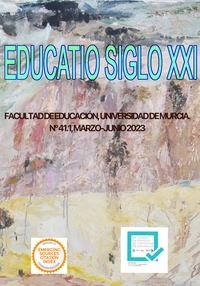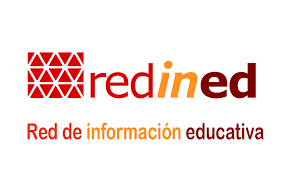The use of textual organizers for reading comprehension in a target language, an experience during the Covid-19 pandemic
Abstract
This study presents an investigation carried out in the European University of the Atlantic, Santander. Its main aim was to create a didactic proposal to improve reading comprehension in the subject of English as a Foreign Language, level 2. This proposal included the use of reading strategies and graphic organizers. Eleven texts from the textbook Macmillan English Hub B1+/ B2- were analyzed. The activities were improved by including a training in the use of reading strategies and a specific graphic organizer for every type of text. To apply the proposal, it was necessary to take a previous and a post reading test as well as 5 extra reading activities as part of the continuous evaluation. The application had to be adapted to online teaching because of the Covid-19 pandemic. The sample of the study consisted of 57 students enrolled in the Science of Sports degree and the Psychology degree. Thirty-one of these students took part in the experimental group, while the other 26 took part in the control group. The results showed that there were significant differences between these two groups. In conclusion, the use of reading strategies together with the training in the use of graphic organizers contributes to an improvement in reading comprehension.
Downloads
-
Abstract1790
-
PDF (Español (España))1255
References
Al-Mahrooqi, R. & Denman, C. (2018). An Exploration of the English-Language Reading Habits of Omani University Students. In English Education in Oman. Current scenarios and future trajectories (pp. 149-159). Singapore: Springer
Barashid, M. (2020). Investigating the critical reading skills for Saudi EFL learners through Graphic Organizers instructional program. Frontiers in Education Technology, 3 (4), 30-63.
Becerra-Polanco, M.; Colli-Novelo, D. y Portillo-Campos, V. (2014). Estrategias de lectura en el aprendizaje de inglés en estudiantes de Quintana Roo. Revista de Educación y Desarrollo, 28, 37-44.
Bernhardt, E. B. (2011). Understanding advanced second language reading. Routledge.
Bloom, B.S.; Engelhart, M.D.; Furst, E.J.; Hill, W.H. y Krathwohl, D.R. (1956). Taxonomy of educational goals. Handbook I: Cognitive domain. David McKay Company.
Campos, A. (2005). Mapas conceptuales, mapas mentales y otras formas de representación del conocimiento. Editorial Magisterio.
Cano, A.G. (2015). Estrategias de comprensión lectora para estudiantes de Magisterio. Educatio Siglo XXI, 33 (2), 123-140. Recuperado de https://revistas.um.es/educatio/article/view/232721/180061
Casas, L. (2018). La mediación docente en el proceso de comprensión lectora con fines académicos en estudiantes de Inglés como lengua extranjera. Educere: Revista Venezolana de Educación (71), 73-84.
Castellanos, S. (2021). Comunicación, pandemia y tecnología. #PerDebate, 5, 12-15.
Cedeño, L.M. (2017). El uso de estrategias metodológicas activas y participativas en la enseñanza aprendizaje de inglés como lengua extranjera y su incidencia en la adquisición de la comprensión lectora en los estudiantes del Instituto de Lenguas de la Universidad Técnica de Manabí. (Tesis Doctoral). Universidad Nacional Mayor de San Marcos, Lima (Perú).
Chávez, E., Ocaña, J., Albán, M. y Paredes, S. (2021). Docencia y comunicación en pandemia desde la carrera de comunicación de la Universidad Estatal de Bolívar. #PerDebate, 5, 192-215.
Ellis, R. (1997). The Study of Second Language Acquisition. Oxford University Press.
Foncubierta, J.M. y Fonseca, M.C. (2018). Comprender el proceso lector en segundas lenguas: cognición y afectividad. Tejuelo, 28, 11-42.
Fonseca-Mora, M.C y Fernández-Corbacho, A. (2017). Revista Española de Lingüística Aplicada/Spanish Journal of Applied Linguistics, 30 (1).
Gass, S.M. y Selinker, L. (2008). Second language acquisition. An introductory course. Routledge.
Gómez, A., Solaz, J.J. y Sanjosé, V. (2011). Competencia en lengua inglesa de estudiantes universitarios españoles en el contexto de EEES: nivel de dominio lingüístico, estrategias metacognitivas y hábitos lectores. Revista de Educación, 363, 154-183.
González, E.M., Carbonell, N., Aguaded, M.C. y Asensio, G.T. (2021). Uso de la herramienta «CMAP Tools» como ayuda para la comprensión lectora de alumnado de Primaria. Tendencias Pedagógicas, 37, 145-155.
González, F.M., e Iraizoz, N. (2003). El mapa conceptual: un instrumento apropiado para comprender textos expositivos. Gobierno de Navarra, Departamento de Educación.
Khajavi, Y. y Ketabi, S. (2012). Influencing EFL Learners’ Reading Comprehension and Self-efficacy Beliefs: The Effect of Concept Mapping Strategy. Porta Linguarum (17), 9-27.
Kintsch, W. y Keenan, J.M. (1973). Reading rate as a function of the number of propositions in the base structure of sentences. Cognitive Psychology, 5, 257-274.
Kintsch, W., Kozminsky, E., Streby, W.J., McKoon, G. y Keenan J.M. (1975). Comprehension and recall of text as a function of content variables. Journal of Verbal Learning and Verbal Behaviour, 14, 196-214.
Kintsch, W., y Van Dijk, T. A. (1978). Toward a model of text comprehension and production. Psychological Review, 85, 363-394.
Koda, K. (2005). Insights into second language reading: A cross-linguistic approach. Cambridge University Press.
Lightbown, P.M. y Spada, N. (2013). How languages are learned. Oxford University Press.
López, J.C. (2017). Mapas conceptuales. En Rubio, O.N., López, J.C., Lalama, J.M., Buenaño, D. y López, P. (Ed.) Técnicas de Estudio. Un Instrumento de trabajo para estudiantes universitarios, 90-101. Universidad Técnica de Cotopaxi.
Macmillan Education (2019-a). Macmillan English Hub B1+/ B2-. Iberia Edition. Macmillan Edition.
Macmillan Education (28 de junio de 2019-b). Linguistic Mediation: What is it and how can we introduce it in ELT? Macmillan Education. https://www.macmillaneducation.es/en/noticias/linguistic-mediation-what-is-it-and-how-can-we-introduce-it-in-elt/
Mairal, R., Pérez, M.B., Teomiro, I.I., Ruiz de Mendoza, F.J. y Peña, M.S. (2018). Teorías lingüísticas. Universidad Nacional de Educación a Distancia.
Meyer, B. (1975). The organization of prose and its effects upon memory. North Holland.
Moncada, B. (2014). Promoción del uso de estrategias para la lectura de textos en inglés. Legenda, 18 (18), 125-145.
Mokhtari, K.; Dimitrov, D. y Reichard, C. (2018). Revising the metacognitive awareness of reading strategies inventory (MARSI) and testing for factorial invariance. University of Texas and Tyler: Education Faculty Publications and Presentations.
Mokhtari, K. y Reichard, C. (2002). Assessing student’s metacognitive awareness of reading strategies. Journal of Educational Psychology, 94 (2), 249-259.
Nassaji, H. (2002). Schema theory and knowledge-based processes in Second Language reading comprehension: A need for alternative perspectives. Language Learning, 52 (2), 439-481.
Novoa, P.F. (2019). El mapa mental armónico en la comprensión y producción de textos narrativos en estudiantes de pregrado de la UCV. (Tesis doctoral). Universidad César Vallejo, Lima (Perú).
Par, L. (2020). The relationship between reading strategies and reading achievement of the EFL students. International Journal of Instruction, 13 (2), 223-238.
Perfetti, C.A. (1986). Cognitive and linguistic components of reading ability, en B. Foorman & A. Siegel (Eds.), Learning to read: cognitive universals and cultural constraints, 11-40. Erlbaum.
Pimienta, J.H. (2012). Estrategias de enseñanza-aprendizaje. Docencia universitaria basada en competencias. Pearson.
Ramírez, V., Fonseca, A.N., Ávila, Z. y Rodríguez, Y. (2022). Las tareas de aprendizaje: una vía para estimular la comprensión de textos escritos. Ciencia y Educación, 3 (1), 6-17.
Regueiro, M.L. (2019). La compleja y rica relación entre el texto y el tipo de lectura. En Ruiz de Zarobe, Y. y Ruiz de Zarobe L. (Ed.). La lectura en lengua extranjera (pp. 32-100). Octaedro.
Rosas, E. (2012). Las estrategias utilizadas para la lectura en español como primera lengua y en inglés como lengua extranjera. Revista Electrónica Educare, 16 (3), 227-252.
Ruiz, E.R., Yumi, L.M. y Dávila, G.P. (2019). Incidencia de los organizadores gráficos en el desarrollo de habilidades escritas en inglés. European Scientific Journal, 15 (13), 95-107.
Sancho, C.; González Such, J. y Bakieva, M. (2014). PSPP. Correlación bivariada. Coeficiente de Pearson. Innovamide L4U. Red de Innovación Educativa y Calidad Docente. Elaboración y evaluación de materiales de aprendizaje. Universitat de València. Recuperado de: http://www.uv.es/innovamide/l4u/PSPP/pspp09/pspp09.wiki
Schleppegrell, M. y Bowman, B. (1986). ESP: teaching English for specific purposes. Center for Applied Linguistics.
Solé, I. (1992). Estrategias de lectura. Graó.
Styati, E. W. e Irawati, L. (2020). The effect of Graphic Organizers on ELT students’s writing quality. Indonesian Journal of EFL and Linguistics, 5 (2), 279-293.
Suescún, C. (2015). Alternative strategies for the reading EFL classroom. Revista Psicoespacios, 9, (15), 3-19.
Tayo, E.A. (2018). El uso de organizadores gráficos para mejorar la destreza lectora en el aprendizaje del idioma inglés. Revista Publicando, 5 (15), 481-500.
Uba, E., Oteikwu, E.A., Onkuwa, E. & Abiodun-Eniayekan E. (2017). A Research-Based Evidence of the Effect of Graphic Organizers on the Understanding of Prose Fiction in ESL Classroom. Sage Open, 1-9.
Van Dijk, T. A., y Kintsch, W. (1983). Strategies of Discourse Comprehension. Academic Press.
Vargas, J.M. y Zúñiga, R. (2018). Graphic organisers as a teaching strategy for improved comprehension of argumentative texts in English. Revista Actualidades Investigativas en Educación, 18 (2). Recuperado de http://dx.doi.org/10.15517/aie.v18i2.33028
Yapp, D.; de Graaff, R. y van den Bergh, H. (2021). Effects of reading strategy instruction in English as a second language on students’ academic reading comprehension. Language Teaching Research, 1-24.
Copyright (c) 2023 Servicio de Publicaciones de la Universidad de Murcia

This work is licensed under a Creative Commons Attribution-NonCommercial-NoDerivatives 4.0 International License.
Original work publishes in this journal is subject to the following terms:
1. Murcia University Press (the publishing house) holds the copyright of the publishes work, and favours and allows their reutilization under the use license stated in point 2.
© Servicio de Publicaciones, Universidad de Murcia, 2015
2. Work is published in the electronic edition under a license (Creative Commons Reconocimiento-NoComercial-SinObraDerivada 4.0 España (legal text). They can be copied, used, disseminated, transmitted and publicly presented, as long as: i) authorship and original publication source is acknowledged (journal, publishing house and URL of the work); ii) are not used for commercial purposes; iii) the existence and specifications of this use license is stated.
3. Conditions for self-archive. Authors are allowed and encouraged to disseminate electronically the pre-pint (before review) and/or post-print (accepted for publication) versions of their work before their publication since that favours earlier circulation and dissemination resulting in an increased chance for the authors to be cited and for the work to reach a bigger share of the academic community. Colour: RoMEO: green.







